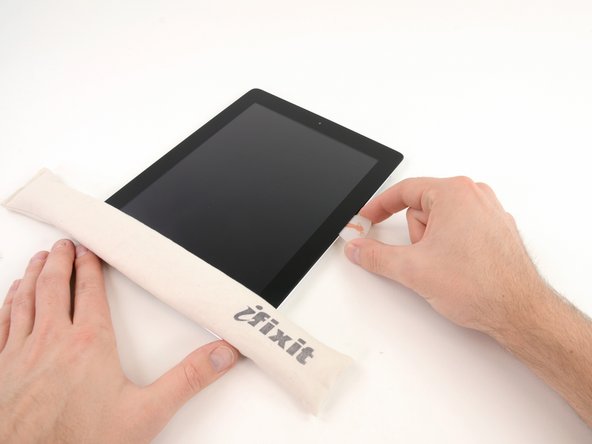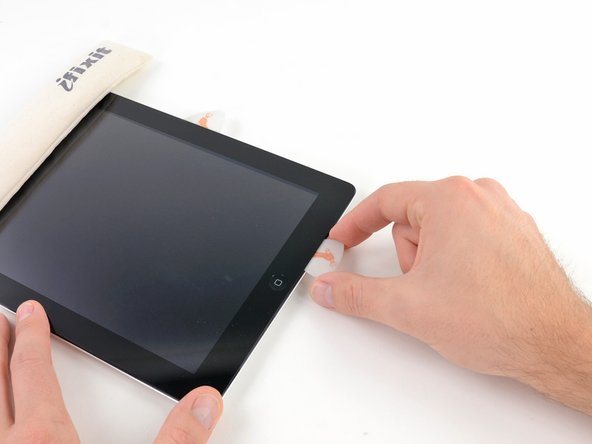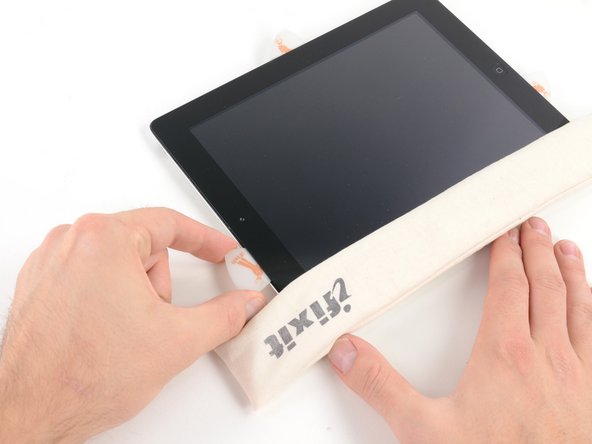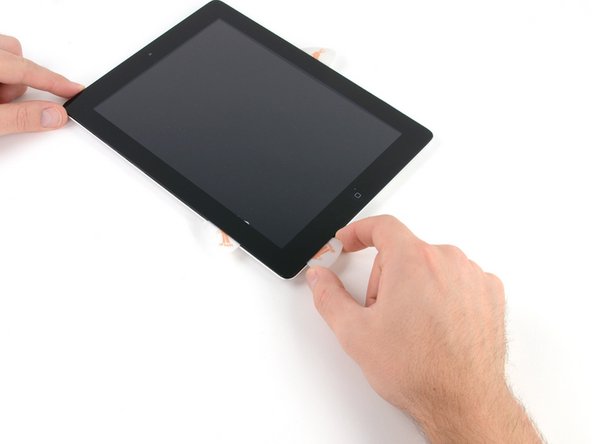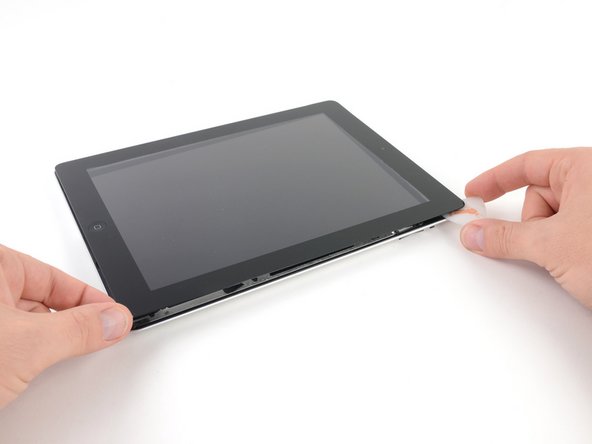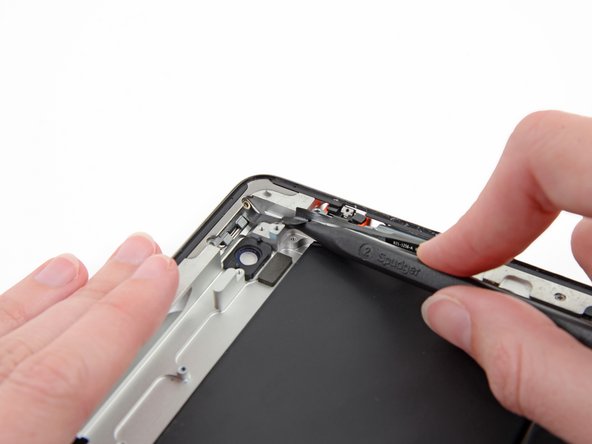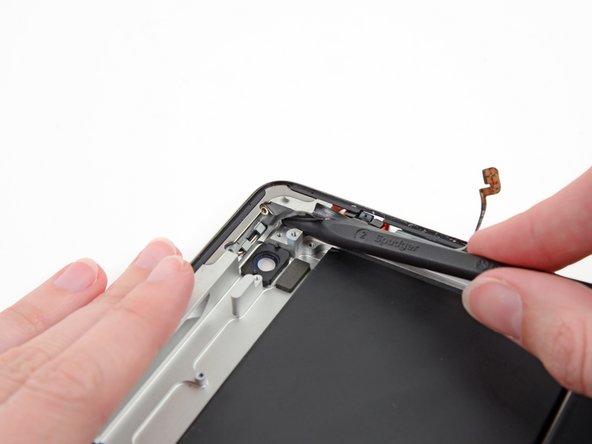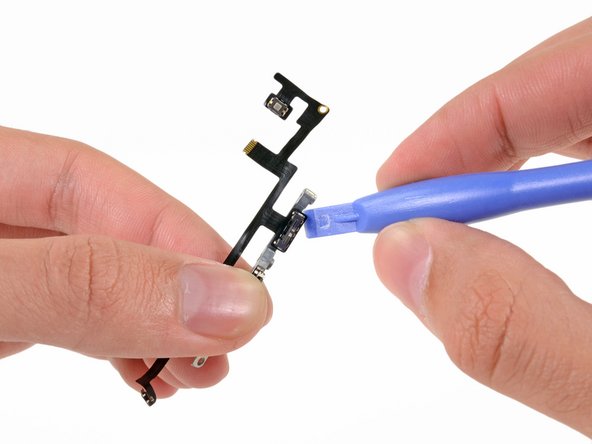DIY iPad 4 Wi-Fi Power Volume Buttons Replacement Guide
Duration: 45 minutes
Steps: 64 Steps
Hey there! Just a quick heads-up: tackling repairs can be a bit tricky, so make sure to take your time and double-check everything. If you find yourself in a jam, don’t hesitate to schedule a repair with us!
Get ready to dive in and swap out those power and volume buttons like a pro! It’s easier than you think. If you need help, you can always schedule a repair.
Step 1
It’s a great idea to give your microwave a quick clean before diving in. Trust us, you don’t want any leftover gunk sticking to the iOpener and making things messy.
– Pop that iOpener right in the middle of your microwave and let it warm up!
Tools Used
Step 2
Hey there! Just a little reminder to keep an eye on the iOpener while you’re working. We don’t want it to get too hot to handle—overheating can make it pop! So, let’s keep it below 100˚C (212˚F).
If the iOpener looks like it’s been hitting the gym and is a bit swollen, steer clear of it, okay?
Still feeling the heat? If the middle of the iOpener is too warm to touch, just hang tight and let it chill for a bit before giving it another go. A well-heated iOpener should keep the warmth for about 10 minutes—perfect for getting the job done!
– Give your iOpener a warm hug in the microwave for thirty seconds.
– As you work your magic on the repair, keep that iOpener cozy by reheating it in the microwave for another thirty seconds whenever it starts to cool down.
Tools Used
Step 3
Caution! The iOpener is going to be pretty toasty, so handle it with care. If it feels too hot to touch, don’t hesitate to grab an oven mitt!
– Carefully take the iOpener out of the microwave, gripping one of the flat ends to steer clear of the hot center. Stay cool and safe!
Tools Used
Step 4
If you’re not rocking a microwave, no worries! Just pop your iOpener into a pot of boiling water and let the magic happen.
– Grab a pot or pan and fill it up with enough water to give your iOpener a nice, cozy bath.
– Heat that water up until it’s bubbling away, then turn off the heat. Safety first, folks!
– Gently place your iOpener into the hot water for about 2-3 minutes. Make sure it’s having a full-on soak.
– Use some trusty tongs to pull that warm iOpener out of the water. Watch out, it’s hot!
– Give the iOpener a good drying off with a towel. We want it to be nice and dry for action.
– And voila! Your iOpener is ready to roll! If it needs a little more warmth, just repeat the process: heat the water, turn off the heat, and let it soak again for 2-3 minutes. Easy peasy!
Tools Used
Step 5
Don’t forget to rock those safety glasses to keep your eyes safe, and watch out for that LCD screen—it’s a delicate beauty!
– Got a cracked display? No worries! To keep things safe and sound during your repair, grab some tape and cover that glass up.
– Use overlapping strips of clear packing tape to shield the iPad’s display until every inch is protected.
– Follow the rest of the guide as best as you can! Just a heads up: once that glass starts cracking, it might want to keep on doing its thing. You might find yourself reaching for a metal prying tool to help scoop out the broken pieces.
Step 6
Just a heads-up! While you’re tackling this repair, you might encounter some pesky shards of glass. To keep your peepers safe from flying debris, we highly recommend rocking a pair of safety glasses. It’s all about protecting those eyes while you get things fixed up!
– Place the iOpener flat against the right edge of the iPad, making sure it sits snugly for optimal contact between the iPad and the iOpener.
– Give it about 90 seconds to work its magic before you dive in to open that front panel.
Tools Used
Step 7
Getting the wedged tip of your trusty opening tool between the glass and plastic might take a bit of elbow grease. Just take your time and be gentle, wiggling that plastic tool back and forth as needed. You’ve got this!
– Hey there! Spot that little gap in the adhesive ring at the upper right corner of your iPad? It’s about 2.0 inches (~5 cm) down from the top. Let’s take advantage of that little flaw and get started!
– Now, grab your tool and line it up with the mute button. Gently slide the tip of your plastic opening tool into the gap between the front glass and the plastic bezel. Just poke in the very tip—enough to make that crack a bit wider. You’ve got this!
Step 9
– With the plastic opening tool snugly positioned between the front glass and the plastic bezel, gently slip a plastic opening pick into the tiny gap right next to your trusty tool. You’re doing great!
Step 10
– Take that trusty plastic opening tool out of your iPad’s pocket and slide the opening pick a little deeper under the front glass—aim for about half an inch. You’ve got this!
Step 12
The adhesive has a strong grip, so you might need to put in some elbow grease. Take it slow and steady!
If you can spot the tip of the opening pick peeking out from under the front glass, give it a gentle tug. While it’s totally safe to have the pick in that deep, it might leave some sticky adhesive marks on the LCD. Just a heads up!
– As the iOpener warms up the bottom edge, start peeling away the adhesive from the right side of your iPad.
– Gently slide the opening pick down the edge of the iPad, freeing the adhesive along the way.
Tools Used
Step 13
As you peel away the adhesive, you might find it helpful to slide the warmed iOpener back onto the right edge of the iPad. This will depend on how much time the iPad has had to cool while you were working your magic.
– If the opening pick decides to cling to the adhesive like a stubborn friend, just give it a gentle ‘roll’ along the iPad’s side to keep releasing that sticky situation.
Tools Used
Step 14
– Before you dive in and pop out that first opening pick from the bottom corner of your iPad, slide a second pick under the right edge of the front glass. This little buddy will help keep the adhesive from sticking back down while you work your magic.
– Give the iOpener a little love and re-heat it, then place it at the top edge of the iPad. You’re doing great!
Tools Used
Step 15
The Wi-Fi antenna is snugly secured to the bottom right corner of the iPad’s rear case with screws and a cable. Given the unique positioning of the Wi-Fi antenna, it’s super important to handle this part with care to avoid any potential mishaps that could lead to some serious damage. Keep it cool and take your time!
– Alright, friends, it’s time to tread carefully! The next few steps need your utmost attention.
– You’ll be gently peeling away the adhesive that holds the antenna to the front panel. Just remember to be super careful not to mess with the delicate bits connecting the antenna to the bottom of the iPad. Stick to the following steps, and you’ll do great!
Step 16
Hey there! Just a friendly reminder: don’t slide that pick past the bottom right corner. You might accidentally give your Wi-Fi antenna a little boo-boo, and we definitely don’t want that!
– Gently glide that trusty opening pick around the bottom right corner of your iPad, and watch as the adhesive gives up the ghost.
Step 17
As you embark on this step, gently glide the opening pick along the bottom right edge of the front panel. Just a heads up: the Wi-Fi antenna is lurking close to the corner, and if the adhesive isn’t released just right, it could get a bit too friendly with your pick!
Keep that pick snug under the front glass—just a little peek-a-boo! Pull it out gently so about ~1/8″ (3 mm) of the tip stays cozy beneath the glass.
– Gently glide the edge of the opening pick along the bottom of the iPad to free up the adhesive covering the Wi-Fi antenna. You’re doing great!
Step 18
– Alright, once you’ve navigated past the Wi-Fi antenna (that’s about 3″ or 75 mm from the right edge, right by the home button), slide that opening pick back in all the way.
– Now, gently glide the pick to the right to free the adhesive that’s keeping the Wi-Fi antenna stuck to the front glass. You’ve got this!
Step 19
Keep it cool, folks! Don’t heat that iOpener for more than a minute at a time, and remember to give it a breather for at least two minutes before giving it another go.
– Keep on peeling back the adhesive at the bottom of the iPad. Make sure to pull the opening pick out far enough to wrap around the home button. Once you’ve successfully navigated past the home button, pop that pick back in to about a half-inch (10 mm) deep. You’re doing great!
Tools Used
Step 20
– Keep peeling away that adhesive along the bottom edge of your iPad—you’re almost there!
– Slide the opening pick snugly under the front glass close to the home button and let it rest there.
Step 22
If your adhesive has gotten a bit too cool, just swap out the iOpener along the top edge and keep on going! If the iOpener itself has chilled out too much, give it a little reheating and you’ll be back in business.
– Gently slide the opening pick along the top edge of your iPad, giving it a little tug to navigate around the front-facing camera bracket.
– The adhesive in this area is pretty robust, so don’t be shy about applying some elbow grease. Just take your time and stay steady to avoid any mishaps with yourself or your iPad.
– If the opening pick feels like it’s playing hard to get in the adhesive, try ‘rolling’ the pick as demonstrated in step 9.
Tools Used
Step 23
Once the adhesive is nice and toasty, go ahead and lift the iOpener off your iPad for a smoother experience. But if it’s still clinging on a bit too tightly, just give that iOpener another heat-up and place it on the left edge while you get to work!
– Keep peeling away that adhesive along the top edge of the iPad, and gently maneuver the opening pick around the top left corner. You’re doing great!
Tools Used
Step 24
The digitizer cable hangs out about 2 inches (50 mm) from the bottom of your iPad. When you’re sliding that pick, make sure to pause when you get to around 2.25 inches (60 mm) from the bottom. You’re doing great!
– Gently glide the opening pick down the left edge of your iPad, releasing that sneaky adhesive as you go! The adhesive here is pretty thin, thanks to the digitizer hanging out along the entire left side. Just remember, keep the pick no deeper than about 1/2 inch (10 mm) to avoid any mishaps with the digitizer. You’ve got this!
Step 25
Be super careful! The bottom of the digitizer cable is just about an inch (25 mm) from the base of your iPad. Take your time and watch out for that cable—let’s not cut it!
– With the trusty opening pick still nestled under the bottom edge of your iPad, gently free the adhesive at the bottom left corner. Keep it smooth and steady!
Step 26
– Grab one of those nifty opening picks and gently lift the bottom right corner of the iPad. Then, give it a little pinch with your fingers to hold it steady.
Step 27
Watch out for any sticky stuff that might still be hanging on! Grab an opening pick and gently slice through any adhesive that’s keeping the front panel in place. You’ve got this!
– Grab your iPad by the top and bottom right corners and give the front glass a gentle twist away from the device. It’s like a little dance move for your tech!
– When putting everything back together, take a moment to use a microfiber cloth and some compressed air to wipe away any dust bunnies or fingerprints from the LCD. It’ll make your screen sparkle before you seal it up!
Step 28
The bottom left screw is playing hide and seek behind the home button ribbon cable connector. Gently slide the home button ribbon cable out of the way to free that pesky bottom left screw.
– Grab your trusty screwdriver and tackle those four 2 mm Phillips #00 screws holding the LCD to the aluminum frame. You’ve got this!
Step 29
Handle the LCD with care! That ribbon cable is a bit delicate and can snap if you bend it too much. You’ve got this!
– Grab your trusty plastic opening tool or a spudger, and gently lift the right edge of that LCD out of your iPad. You’re doing great!
– Now, swing the LCD around its left edge and carefully lay it down on the front glass panel. Almost there!
Tools Used
Step 30
– With the spudger’s tip in hand, gently lift away the tape that’s hiding the LCD ribbon cable connector. You’ve got this!
Tools Used
Step 31
– Gently lift the retaining flap on the LCD ribbon cable ZIF connector.
– With a steady hand or a trusty pair of tweezers, carefully pull the LCD ribbon cable out of its cozy socket on the logic board.
Tools Used
Step 32
– Gently lift the LCD away from the front panel, making sure not to touch the screen itself.
Step 33
If you spot it, go ahead and peel off that piece of electrical tape that’s hiding the Wi-Fi antenna, speaker cable, and home button ribbon cable. You’re doing great!
Step 34
– Gently lift the retaining flap on the home button ribbon cable ZIF connector like you’re opening a secret compartment!
Step 35
– Grab a trusty pair of tweezers and gently tug the home button ribbon cable straight out of its cozy socket on the logic board. You’ve got this!
Tools Used
Step 37
– Grab your trusty tweezers and gently lift the piece of tape that’s keeping the digitizer ribbon cable snug against the logic board. You’ve got this!
Tools Used
Step 38
– Gently lift the retaining flap on both of the digitizer ribbon cable ZIF connectors. You’ve got this!
Step 39
– Grab your trusty spudger and gently work the flat end under the digitizer ribbon cable to break that adhesive seal.
– With a steady hand, pull the digitizer ribbon cable straight out from its cozy little sockets on the logic board.
Tools Used
Step 40
– Gently lift the digitizer ribbon cable and grab your trusty spudger. Use the flat end to carefully break the adhesive bond holding the cable to the back of the aluminum case. You’ve got this!
Tools Used
Step 41
– Gently use your fingers to wiggle that digitizer ribbon cable free from its cozy spot in the aluminum frame.
– Carefully lift away the front panel from your iPad.
Step 42
– Grab your trusty tweezers and gently peel back that pesky piece of electrical tape hiding the headphone jack assembly cable connector. You got this!
– Now, with the tip of your spudger, give a little lift to the retaining flap on both ZIF connectors holding the headphone jack cable to the logic board. It’s like unlocking a secret door!
Step 43
– Gently slide the flat end of your trusty spudger underneath the headphone jack assembly cable to break free the adhesive that’s holding it snug against the rear aluminum frame.
– Once it’s loose, pull the headphone jack assembly cable straight out of its cozy socket on the logic board.
Tools Used
Step 44
– Gently nudge the front-facing camera ribbon cable aside using the flat edge of a spudger, but remember, no need to remove it completely!
Tools Used
Step 45
– Gently peel away the adhesive tape that’s holding down the headphone jack assembly. You’re almost there!
Step 47
– Gently slide the tip of the spudger under the microphone ribbon cable and coax it out of its cozy little home in the ZIF connector.
– With the flat edge of your trusty spudger, nudge the microphone ribbon cable to the side and give it some space.
Tools Used
Step 48
– Gently lift the retaining flap that holds the volume/power button ribbon cable connector to the headphone jack assembly board. You’ve got this!
Step 49
– Carefully slide the volume button ribbon cable out of its ZIF connector. You’re doing great!
– Gently lift the volume button ribbon cable upwards to set it aside. Keep it up!
Step 51
– Gently grasp the ribbon cable attached to the headphone jack assembly and lift it upwards towards the top of the device with care.
Step 52
– With one hand, grab hold of the headphone jack assembly and gently pull it away from the iPad, being careful of any cables that might be in the way.
Step 53
The two screws at the top are cleverly angled into the aluminum frame. Just remember to keep your screwdriver aligned with the screw for a smooth ride!
– Unscrew the screws holding the power and volume button cable to the aluminum frame like a pro!
Step 55
This screw is positioned at an angle into the aluminum frame. Make sure to keep your screwdriver aligned with the screw for a smooth operation.
– Let’s get started by gently removing the lone 2.6 mm Phillips #00 screw that’s keeping the volume button frame snugly attached to the aluminum frame. You’ve got this!
Step 56
– Gently slide the edge of a plastic opening tool beneath the sleep/wake sensor, but take it easy—those delicate cables can be a bit touchy.
– Carefully maneuver the plastic opening tool around the sensor to help release that sticky adhesive. You’re doing great!
Step 58
– Grab that spudger and use its pointy tip instead of the flat side to gently peel back the adhesive snugly holding the volume button branch of the ribbon cable.
– Keep sliding that spudger tip toward the top of the iPad, and watch as the adhesive gives way like it’s on vacation.
– With the spudger still under the ribbon cable, carefully lift the power button out of its cozy little home in the aluminum frame.
Tools Used
Step 59
– Gently lift the power & volume button cable out of the iPad, like you’re giving it a little hug goodbye!
Step 60
– Gently slide the edge of your trusty plastic opening tool under the top side of the power button.
– Carefully lift the top side of the power button away from its bracket, giving it a little nudge.
Step 61
– Give the underside of that power button a little love, just like you did before!
– Now, gently lift and take off the power button bracket from the power & volume button assembly. You’ve got this!
Step 62
– Gently slide the tip of your trusty plastic opening tool under the top edge of the rotation lock/mute switch. It’s like giving it a little nudge to say, ‘Hey there!’
– Now, with a smooth motion, glide the plastic opening tool downwards to pop the topside of the rotation lock/mute switch free from its cozy bracket. You’re doing great!
Step 63
– Gently slide the tip of your trusty plastic opening tool under the top volume rocker and give it a little nudge upwards to pop it free from the volume buttons bracket.
– Now, just repeat that same smooth move to detach the bottom volume rocker from the volume buttons bracket.
Step 64
– Gently lift and detach the ribbon cable for the power and volume buttons. You’ve got this!
























